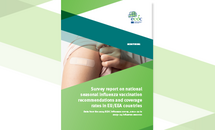Survey report on national seasonal influenza vaccination recommendations and coverage rates in EU/EEA countries
This survey report provides information that can support national public health institutes and policy-makers with the development of seasonal influenza vaccination programmes and supporting activities.
Executive summary
The 2024 ECDC influenza survey on national vaccination recommendations and coverage used and adapted the previous ECDC-funded survey conducted by the Vaccine European New Integrated Collaboration Effort (VENICE) project. The aim of the survey was to describe the evolution of seasonal influenza vaccine recommendations in European Union/European Economic Area (EU/EEA) countries during the 2023−24 influenza season, and to describe trends in national influenza vaccination coverage rates (VCRs) during the 2021−22,
2022−23 and 2023−24 influenza seasons.
Out of the 30 EU/EEA countries invited to participate in the survey, 29 completed the questionnaire (97% response rate). For the country that did not participate in the survey, we performed a desk review of its national public health agency website to collect the relevant recommendations.
Vaccination in children and adolescents – Twenty EU/EEA countries reported age-based recommendations for children and/or adolescents, regardless of underlying medical conditions, for the 2023–24 season. This is a notable increase from the 2020–21 season, when only 14 countries had recommendations, and a significant increase from the 2017–18 season, when only five countries had recommendations.
Of the 20 countries with recommendations, 13 reported VCRs during the 2023–24 season (range: 0.9%–38.9%), with Finland (38.9%), Spain (36.1%) and Denmark (16%) reporting the highest VCRs. Comparison with data collected in the previous survey is not possible because different countries reported data and there was
heterogeneity in the age groups reported, which at times did not reflect the age cut-off of the recommendation.
Vaccination in older adults – All EU/EEA countries reported recommendations for older adults for the 2023–24 season. There was some variation in the lower age limit, ranging from 50 years old to 65 years old.
Overall, vaccination coverage over the three seasons showed a relatively stable trend (<3% change), but some downward fluctuations were observed in the 2023–24 season compared with the previous two seasons (range: 3%–10% for 17 countries reporting data for the overall period). The median VCR for 2023–24 was 45.7%, compared with 59% in the 2020–21 season. While data should be interpreted carefully, there is an indication that seasonal influenza vaccination programmes in older adults may be in decline following several years of
stagnant uptake in the pre-COVID-19 pandemic period. Such trends must be carefully investigated and validated, as older adults are the primary target of seasonal influenza vaccination programmes.
Vaccination in individuals with chronic medical conditions – All EU/EEA countries had specific recommendations for adults with chronic medical conditions in the 2023–24 season. Although there were minor variations in the conditions covered, all countries recommended the vaccine for chronic pulmonary, cardiovascular, renal and metabolic conditions, as well as immunosuppression. As most countries did not have VCR data available for this group, no such data are presented in this report.
Vaccination in pregnancy – All EU/EEA countries except one had national recommendations for influenza vaccination during pregnancy in the 2023–24 season. Compared with the 2020–21 season, two countries expanded their programmes to include all pregnant women regardless of medical conditions. Of these 29 countries, eight reported VCRs (range: 1%–58%) in the 2023–24 season.
Vaccination in healthcare workers – Twenty-three EU/EEA countries had recommendations for all healthcare workers for the 2023–24 season. Six additional countries recommended the vaccine for specific medical staff, such as those in close contact with patients or contaminated materials.
Ten countries reported VCRs for healthcare workers (range: 5%–58%). The median VCR in the 2023–24 season was 22.1%, down from 25% in 2022–23 and 28% in 2021–22. Most countries reported a decrease in VCRs for healthcare workers compared with the 2020–21 season, when a median of 52% was reported.
In general, EU/EEA countries continue to recommend influenza vaccination for the primary target groups (older adults, individuals with chronic medical conditions, pregnant women and healthcare workers). Some countries have expanded recommendations for seasonal influenza vaccination in recent years in children. This signals important public health efforts to strengthen the prevention of seasonal influenza by making the vaccine more widely available to the groups that could benefit most from the programme. Nonetheless, when looking at the performance of such programmes through the reported national vaccination coverage data, it is evident that policies still fall short of meeting sufficient levels of uptake across key target groups.
VCRs varied across target groups and countries during the three seasons included in this report. A limited number of countries showed slight increases in coverage but the majority experienced a decline. Although comparison across countries and years must be done with caution, the decline since the 2020–21 season appears to be more substantial for critical target groups such as older adults and healthcare workers.
Most countries are still far from reaching adequate levels of protections for key target groups. Seasonal influenza vaccination remains a key public health intervention, making it essential to implement targeted strategies to increase vaccine uptake and address barriers to vaccination. Efforts to expand recommendations must be bolstered by efforts to improve implementation and increase the benefits of seasonal influenza vaccination programmes. At the same time, there is an important need to develop a new generation of equally safe yet more effective influenza vaccines, which may help fight complacent attitudes and increase trust in this fundamental vaccination programme.







